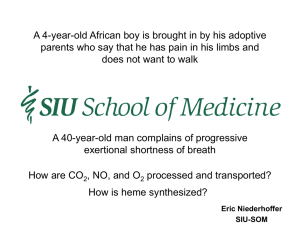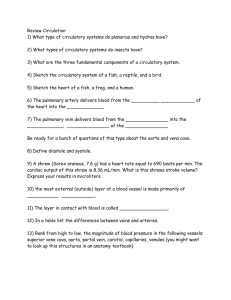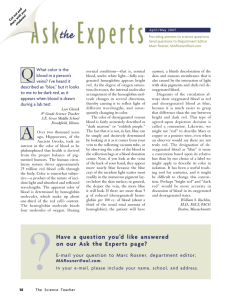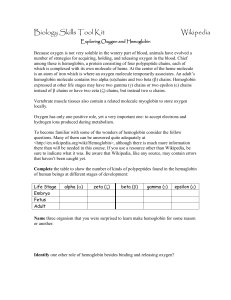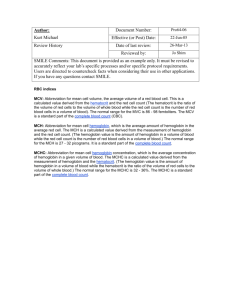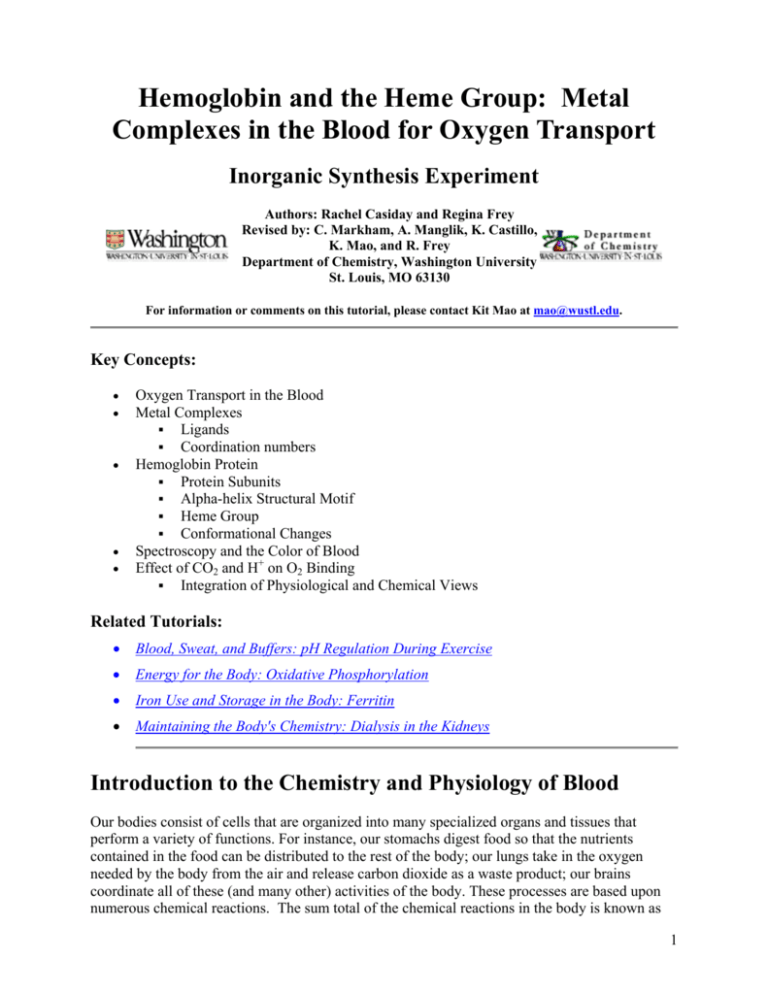
Hemoglobin and the Heme Group: Metal
Complexes in the Blood for Oxygen Transport
Inorganic Synthesis Experiment
Authors: Rachel Casiday and Regina Frey
Revised by: C. Markham, A. Manglik, K. Castillo,
K. Mao, and R. Frey
Department of Chemistry, Washington University
St. Louis, MO 63130
For information or comments on this tutorial, please contact Kit Mao at mao@wustl.edu.
Key Concepts:
•
•
•
•
•
Oxygen Transport in the Blood
Metal Complexes
Ligands
Coordination numbers
Hemoglobin Protein
Protein Subunits
Alpha-helix Structural Motif
Heme Group
Conformational Changes
Spectroscopy and the Color of Blood
Effect of CO2 and H+ on O2 Binding
Integration of Physiological and Chemical Views
Related Tutorials:
•
Blood, Sweat, and Buffers: pH Regulation During Exercise
•
Energy for the Body: Oxidative Phosphorylation
•
Iron Use and Storage in the Body: Ferritin
•
Maintaining the Body's Chemistry: Dialysis in the Kidneys
Introduction to the Chemistry and Physiology of Blood
Our bodies consist of cells that are organized into many specialized organs and tissues that
perform a variety of functions. For instance, our stomachs digest food so that the nutrients
contained in the food can be distributed to the rest of the body; our lungs take in the oxygen
needed by the body from the air and release carbon dioxide as a waste product; our brains
coordinate all of these (and many other) activities of the body. These processes are based upon
numerous chemical reactions. The sum total of the chemical reactions in the body is known as
1
the body's metabolism. Human metabolism includes the reactions needed for normal activities
such as eating, sleeping, and studying.
All of our specialized organs are united by their fundamental need for a particular chemical
environment that will enable the body's metabolic reactions. This environment must supply
oxygen and nutrients to furnish the building blocks for cells, enable biochemical reactions, and
provide energy for the body. Additionally, it must be able to eliminate the waste products of the
body's metabolic activities.
Blood distributes oxygen and nutrients to the many different cells in the body, carries CO2
generated by the cells to the lungs for exhalation, and carries other waste products to the kidneys
and liver for processing and elimination. Many finely tuned chemical processes occur in the
blood to allow it to perform all of these functions and provide for the needs of the body. The
tutorials in Chem 151 and 152 will describe several of these vital chemical processes, such as the
release of iron in controlled amounts to the blood, the removal of waste products from the blood ,
and the regulation of the levels of CO2 and H+ to control the pH of the blood. In this tutorial, we
will focus primarily on one of the most important functions of blood: the transport of oxygen
from the lungs to the other cells of the body (e.g., muscle cells) that perform metabolic functions.
Oxygen Transport via Metal Complexes
An adult at rest consumes the equivalent of 250 mL of pure oxygen per minute. This oxygen is
used to provide energy for all the tissues and organs of the body, even when the body is at rest.
The body's oxygen needs increase dramatically during exercise or other strenuous activities. The
oxygen is carried in the blood from the lungs to the tissues where it is consumed. However, only
about 1.5% of the oxygen transported by the blood is dissolved directly in the blood plasma. In
fact, most of the oxygen is carried via a more sophisticated mechanism that utilizes the metal
complex heme. This mechanism is capable of transporting the large amount of oxygen required
by the body and allowing it to leave the blood when it reaches the tissues that demand the most
oxygen.
Metal Complexes in the Body
Metal ions are ideal for use in biological systems due to their ability to coordinate with (bind)
and then release ligands. The most common metal used in the body is iron, which plays a central
role in almost all living cells. For example, iron complexes are used in the transport of oxygen in
the blood and tissues.
Metal-ion complexes consist of a metal ion that is bonded via coordinate-covalent bonds (Figure
1) to a small number of anions or neutral molecules called ligands. For example, the ammonia
(NH3) ligand used in this experiment is a monodentate ligand; i.e., each monodentate ligand in a
metal-ion complex occupies only one site in the coordination sphere of a metal ion. Some ligands
have two or more electron-pair-donor atoms that can simultaneously coordinate to a metal ion
and occupy two or more coordination sites; these ligands are called polydentate ligands. They
are also known as chelating agents (from the Greek word meaning "claw") because they appear
to grasp the metal ion between two or more electron-pair-donor atoms. One of the most
important classes of chelating agents in nature is the porphyrins (Figure 1a). A porphyrin
molecule can coordinate to a metal using its four nitrogen atoms as electron-pair donors, thus
2
prophyrins are tetradentate ligands. The coordination number for a metal refers to the total
number of occupied coordination sites around the central metal ion (i.e., the total number of
metal-ligand bonds in the complex).
NH
N
N
HN
Figure 1a (left). 2D representation of a porphyrin.
Figure 1b (right). A covalent bond forms when electrons are shared between
atoms. A coordinate-covalent bond (represented by a green arrow) forms when
both of the shared electrons come from the same atom, called the donor atom
(blue). The top illustration shows a coordinate-covalent bond between a metal ion
(e.g., Fe, shown in red) and a monodentate ligand (shown in light blue). The
bottom illustration shows a metal ion with coordinate-covalent bonds to a bidentate
ligand (shown in yellow).
Oxygen-Carrying Protein in the Blood: Hemoglobin
Hemoglobin is the protein that transports oxygen (O2) in human blood from the lungs to the
tissues of the body. Proteins are formed by the linking of amino acids into polypeptide chains.
An individual amino acid in a protein is known as a residue. The arrangement and interactions of
the amino-acid residues within the protein determine the protein's shape and contribute
substantially to its function. Hemoglobin is a globular protein (i.e., folded into a compact,
nearly spherical shape) and consists of four subunits, as shown in Figure 2. Each protein subunit
is an individual molecule that joins to its neighboring subunits through intermolecular
interactions.
3
Figure 21
This is a molecular model of hemoglobin with the subunits displayed in the ribbon
representation which traces the backbone atoms of a protein. The four heme groups are
displayed in the ball-and-stick representation and is used to represent the 3-D structure
of the protein.
Note: To view the molecule interactively,
please use Chime.
To understand the oxygen-binding properties of hemoglobin, we will focus briefly on the
structure of the protein and the metal complexes embedded in it.
The Protein Subunit
Each subunit in Figure 2 contains regions with a coiled shape. Many of the amino acids that
make up the polypeptide chain interact to form this particular structure, called an alpha helix. In
an alpha helix (Figure 3), each amino acid is hydrogen-bonded to the amino acid that is four
residues ahead of it in the chain. In hemoglobin, the hydrogen-bonding interaction occurs
between the H of an -NH group and the O of a -CO group of the polypeptide backbone chain; the
amino-acid side chains extend outward from the backbone of the helix. Approximately 75% of
the amino-acid composition of hemoglobin adopts an alpha-helical structure. Another common
structural motif is the beta-pleated sheet, in which amino acids line up in parallel rows.
1
The coordinates for the hemoglobin protein were determined using x-ray crystallography, and the image was
rendered using SwissPDB Viewer and POV-Ray.
4
Figure 3
This is a molecular model of the alpha-helix structure in a subunit of hemoglobin. The
blue strands are shown in the ribbon representation to emphasize the helical structure.
The green dotted lines show the hydrogen bonding between the -NH and -CO functional
groups. Note: To view the molecule interactively, please use Chime.
The Heme Group
In hemoglobin, each subunit contains a heme group, which is displayed using the ball-and-stick
representation in Figure 2. Each heme group contains an iron atom that is able to bind to one
oxygen (O2) molecule. Because hemoglobin contains four heme groups, each hemoglobin
protein can bind four oxygen molecules.
In the body, the iron in the heme is coordinated to the four nitrogen atoms of a porphyrin and
also to a nitrogen atom of a histidine amino-acid residue in the hemoglobin protein (Figure 4).
The sixth position (coordination site) around the iron of the heme is occupied by O2 when the
hemoglobin protein is oxygenated.
5
Figure 4
On the left is a three-dimensional molecular model of heme coordinated to the histidine
residue (a monodentate ligand) of the hemoglobin protein. On the right is a twodimensional drawing of heme coordinated to the histidine residue, which is part of the
hemoglobin protein. In this figure, the protein is deoxygenated; i.e., there is no oxygen
molecule bound to the heme group.
Note: The coordinate-covalent bonds between the central iron atom and the nitrogens
from the porphyrin are shown in gold; the coordinate-covalent bond between the central
iron atom and the histidine residue is shown in green. In the three-dimensional model,
the carbon atoms are gray, the iron atom is dark red, the nitrogen atoms are dark blue,
and the oxygen atoms are light red. The rest of the hemoglobin protein is purple.
Note: To view the molecule interactively,
please use Chime.
Conformational Changes Upon Binding of Oxygen
Careful examination of Figure 4 demonstrates that the heme group is nonplanar when in its
deoxygenated state; the iron atom is pulled out of the plane of the porphyrin toward the histidine
residue to which it is attached. This nonplanar configuration is characteristic of the deoxygenated
heme group and is commonly referred to as a “domed” shape. The valence electrons in the atoms
surrounding the iron in the heme group and the valence electrons in the histidine residue form
“clouds” of electron density. (Electron density refers to the probability of finding an electron in a
region of space.) Because electrons repel one another, the regions occupied by the valence
electrons in the heme group and in the histidine residue are pushed apart. Hence, the porphyrin
adopts the domed (nonplanar) configuration in which the Fe is out of the plane of the porphyrin
ring (Figure 5, left). However, when the heme group is in its oxygenated state, the porphyrin ring
6
adopts a planar configuration in which the Fe lies in the plane of the porphyrin ring (Figure 5,
right).
Figure 5
On the left is a schematic diagram showing representations of electron-density clouds of
the deoxygenated heme group (pink) and the attached histidine residue (light blue).
On the right is a schematic diagram showing representations of electron-density clouds
of the oxygenated heme group (pink), the attached histidine residue (light blue), and the
attached oxygen molecule (gray).
The planar and nonplanar configurations of the heme group have important implications for the
rest of the hemoglobin protein. When the iron atom moves into the porphyrin plane upon
oxygenation, the histidine residue to which the iron atom is attached is drawn closer to the heme
group. This movement of the histidine residue shifts the position of other amino acids that are
near the histidine (Figure 6). When the amino acids in the protein are shifted by the oxygenation
of one of the heme groups, the structure of the interfaces between the four subunits is altered.
This causes the whole protein to change its shape. In the new shape, it is easier for the other
three heme groups to become oxygenated. Thus, the binding of one molecule of O2 to
hemoglobin enhances the ability of hemoglobin to bind more O2 molecules. This property of
hemoglobin is known as cooperative binding.
7
Figure 6
This figure shows the heme group and the portion of the hemoglobin protein that is
directly attached to the heme. As shown in the figure, the conformational change in the
heme group upon oxygenation causes the entire hemoglobin protein to change its
conformation as well. Please click on the pink button below to view a QuickTime
movie showing how the amino acid residues near the heme group in hemoglobin shift as
the heme group converts between the nonplanar (domed) and the planar conformation by
binding and releasing a molecule of O2.
Spectroscopy and the Color of Blood
The changes that occur in blood upon oxygenation and deoxygenation are visible not only at the
microscopic level, as detailed above, but also at the macroscopic level. Clinicians have long
noted that blood in the systemic arteries (traveling from the heart to the oxygen-using cells of the
body) is red-colored, while blood in the systemic veins (traveling from the oxygen-using cells
back to the heart) is blue-colored (Figure 7). The blood in the systemic arteries is oxygen-rich;
this blood has just traveled from the lungs (where it picked up oxygen inhaled from the air) to the
heart. The heart then pumps the blood throughout the body so that it can deliver its oxygen to
the body's cells. The blood in the systemic veins, on the other hand, is oxygen-poor; it has
unloaded its oxygen to the body's cells (exchanging the O2 for CO2, as described below), and
must return to the lungs to replenish its supply of oxygen.
What causes this color change in the blood? We know that the shape of the heme group and the
hemoglobin protein changes, depending on whether hemoglobin is oxygenated or deoxygenated.
Therefore, these two conformations must have different light-absorbing properties. Recall that
the color of a substance is the complementary color of what it absorbs. The oxygenated
conformation of hemoglobin absorbs light in the blue-green range, and it reflects red light. This
property accounts for the red appearance of oxygenated blood. On the other hand, the
deoxygenated conformation of hemoglobin absorbs light in the orange range, and it reflects blue
light. This property accounts for the bluish appearance of deoxygenated blood. We could use a
spectrophotometer to examine a dilute solution of blood and determine the wavelength of light
absorbed by each conformation.
8
The Effect of CO2 and H+ on O2 Binding
In 1904, Christian Bohr discovered that increased concentrations of CO2 and H+ promote the
release of O2 from hemoglobin in the blood. This phenomenon, known as the Bohr effect, is a
highly adaptive feature of the body's blood-gas exchange mechanism. The blood that is pumped
from the heart to the body tissues and organs (other than the lungs) is rich in oxygen (Figure 7)
because these tissues require oxygen for their metabolic activities (e.g., muscle contraction). It is
necessary for oxygen to remain bound to hemoglobin as the blood travels through the arteries so
that it can be carried to the tissues. At the same time, the oxygen must also be easily removable
when the blood passes through the capillaries that feed the body tissues. CO2 and H+ are
produced from metabolic activities of the body, and so the concentration of these species is high
in the metabolically active tissues of the body. Thus, the tissues that perform the most metabolic
activity (and therefore require the largest amount of O2) produce large quantities of CO2 and H+,
facilitating the release of O2 from the blood where the O2 is most needed. In the lungs, the
reverse effect occurs: high concentrations of O2 cause the release of CO2 from hemoglobin.
Figure 7 A schematic diagram of the flow of
blood through the circulatory system
1. Blood rich in carbon dioxide is pumped
from the heart into the lungs through the
pulmonary arteries.
2. In the lungs, CO2 in the blood is
exchanged for O2.
3. The oxygen-rich blood is carried back to
the heart through the pulmonary veins.
4. This oxygen-rich blood is then pumped
from the heart to the many tissues and
organs of the body through the systemic
arteries.
5. In the tissues, the arteries narrow to tiny
capillaries. Here, O2 in the blood is
exchanged for CO2.
6. The capillaries widen into the systemic
veins, which carry the carbon-dioxiderich blood back to the heart.
Note: The components of this diagram were not
drawn to scale.
How do CO2 and H+ promote the release of O2 from hemoglobin? These species help form
interactions between amino-acid residues at the interfaces of the four subunits in hemoglobin.
These interactions are called salt bridges because they are formed between positively-charged
and negatively-charged amino-acid residues on different subunits of the same protein (Figure 8).
When salt bridges form, the subunits of hemoglobin are held in a position that "tugs on" the
histidine that is attached to the heme iron. (Figure 5.) This favors the domed configuration, the
deoxygenated form of hemoglobin.
9
Figure 8
On the left is a schematic diagram of the interface of two subunits of the deoxygenated
hemoglobin protein. In the presence of CO2 and H+ (e.g., in the muscles), charged groups
are formed on the amino-acid residues lining the subunit interface. These charged groups
are held together by ionic interactions, forming salt bridges between the two subunits and
stabilizing the deoxygenated form of hemoglobin. When blood passes through the
alveolar capillaries of the lungs, CO2 and H+ are removed from the hemoglobin, and the
oxygenated configuration is favored (right).
Note: The components of this diagram are not drawn to scale.
When the concentration of protons (H+) is low (pH 9), positive charges do not form on the
residues at the subunit interfaces, so the salt bridges cannot form (right image in Figure 8).
However, at pH 7, histidine residues at the subunit interfaces (not the histidine residues that bind
the heme groups) can accept an additional proton (H+) and hence become positively charged
(Equation 1). When salt bridges form by the interaction of these interfacial histidine residues and
nearby negatively charged amino-acid residues, the deoxygenated hemoglobin structure is
favored, and oxygen is released (left image in Figure 8).
(1)
The number of negatively charged residues in the salt bridges is increased in the presence of
carbon dioxide. CO2 binds to the amino (-NH2) group of certain amino acid residues at the
subunit interfaces to produce a negatively charged group (-NHCOO-) on the residue (Equation
2). This negatively charged group can form salt bridges with the positive charges on the
protonated histidines described above. The H+ produced by Equation 2 can also be accepted by
histidine residues at the subunit interfaces (via Equation 1).
10
(2)
Thus, the changing of the overall protein structure regulates hemoglobin’s biological function.
This structure is altered by the binding or releasing of CO2 and H+ to the interfaces of the
subunits in hemoglobin (Figure 8).
Summary
Blood is an amazing and vitally important part of the body because it contains many finely tuned
chemical systems that allow it to maintain the chemical environment needed for the body's
metabolism. One of the most important functions of blood is delivering O2 to all parts of the
body by the hemoglobin protein. The heme group of the hemoglobin protein carries the O2
molecule. The heme group (a component of the hemoglobin protein) is a metal complex, with
iron as the central metal atom that can bind or release molecular oxygen. Both the hemoglobin
protein and the heme group undergo conformational changes upon oxygenation and
deoxygenation. When one heme group becomes oxygenated, the shape of hemoglobin changes in
such a way as to make it easier for the other three heme groups in the protein to become
oxygenated as well. This feature helps the protein to pick up oxygen more efficiently as the
blood travels through the lungs. Hemoglobin also enables the body to eliminate CO2, which is
generated as a waste product, via gas exchange in the blood (CO2 is exchanged for O2 in the
lungs, and O2 is exchanged for CO2 in the muscles). The species generated as waste by the
oxygen-consuming cells actually help to promote the release of O2 from hemoglobin when O2 is
most needed by the cells. Hence, hemoglobin is an example of a sophisticated chemical system
of the body that enables the blood to deliver necessary molecules to cells and remove waste
products from those cells.
CHIME Files
To view the molecules interactively, please use Chime. To download the PDB files for viewing
and rotating the molecules shown above, please click on the appropriate name below or on the
"interactive" button below each molecular-model figure in the text.
•
Alpha-helix structure (alphahelix.pdb)
•
One subunit from Hemoglobin (subunit.pdb)
•
Hemoglobin (hemoglobin.pdb)
•
Heme group bound to histidine residue (heme.pdb)
11
Additional Links:
•
•
Naming Coordination Compounds summarizes the steps and provides examples of
naming compounds containing coordination complexes.
For additional information on hemoglobin, see the hemoglobin tutorial by Eric Martz of
the University of Massachusetts.
Note: You need CHIME to view this tutorial. You can download Chemscape
Chime here.
•
To learn about porphyrin and other chelating agents, see this "Chemical of the Week" site
from the University of Wisconsin.
•
Another porphyrin molecule, similar to heme but containing Mg rather than Fe as the
central atom, is chlorophyll. You can learn about the structure, function, and
spectroscopy of chlorophyll from this site. (Note: You will be studying chlorophyll in lab
at the beginning of Chemistry 152.)
References:
Guex, N. and Peitsch, M.C. Electrophoresis, 1997, 18, 2714-2723. (SwissPDB Viewer) URL:
http://www.expasy.ch/spdbv/mainpage.htm.
Ji, X. et al. "Positive and negative cooperativities at subsequent steps of oxygenation regulate the
allosteric behavior of multistate sebacylhemoglobin," (1996) Biochemistry, 35, 3418.
Hemoglobin PDB coordinates, Brookhaven Protein Data Bank.
Kavanaugh, J.S. et al. "High-resolution x-ray study of deoxyhemoglobin Rothschild 37beta trp>arg: a mutation that creates an intersubunit chloride-binding site," (1992) Biochemistry, 31,
4111. Deoxyhemoglobin PDB coordinates, Brookhaven Protein Data Bank.
Kilmartin, J.V. "Interaction of haemoglobin with protons, CO2, and 2,3-diphosphoglycerate,"
(1976) Br. Med. Bull., 32, 209.
Persistence of Vision Ray Tracer (POV-Ray). URL: http://www.povray.org.
Royer Jr., W.E. "High-resolution crystallographic analysis of co-operative dimeric hemoglobin,"
J. Mol. Biol., 235, 657. Oxyhemoglobin PDB coordinates, Brookhaven Protein Data Bank.
Stryer, L. Biochemistry, 4th ed. W.H. Freeman and Co., New York, 1995, p. 154-168.
Acknowledgements:
12
The authors thank Greg Noelken for creating the chime script files. They also wish to thank
Dewey Holten, Michelle Gilbertson, Jody Proctor and Carolyn Herman for many helpful
suggestions in the writing of this tutorial.
The development of this tutorial was supported by a grant from the Howard Hughes Medical
Institute, through the Undergraduate Biological Sciences Education program, Grant HHMI#
71199-502008 to Washington University.
Copyright 1998, Washington University, All Rights Reserved.
Revised August 2007.
13

